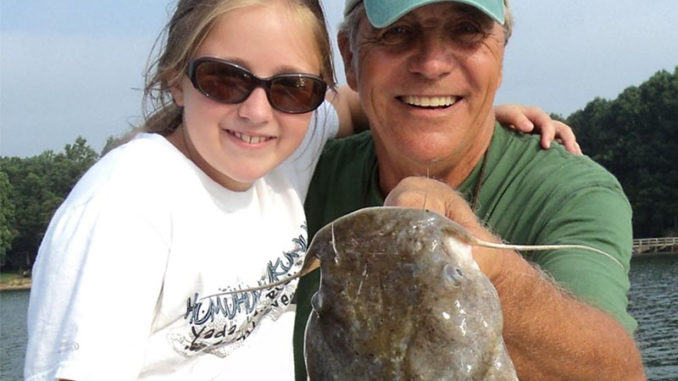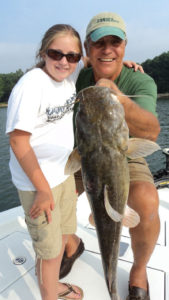
Flatheads are very active in July
Guide Gus Gustafson said if fishermen want to catch big cats weighing 15 pounds or more during summer, they should visit Lake Norman. It’s a North Carolina stronghold for flathead and blue cats.
Gustafson (www.fishingwithgus.com) said while flatheads can exceed 50 pounds — as can blue cats — they bite much better through summer than more cold-natured blues. This makes flatheads the preferred species for July fishing.
Another distinguishing feature is that flatheads are aggressive predators. And they rely more upon sight than smell to feed, a factor that Gustafson takes advantage of while targeting them.
“Flatheads prefer live bait — white perch, bream, shad and herring — while blues prefer cut baits,” Gustafson said. “That doesn’t mean flatheads won’t dine on large strips of cut bait if they are fished a few feet off the bottom where they can see them.”
For really big flatheads, Gustafson said many anglers use live goldfish, buying the baits at pet stores if they can’t find them at bait shops.
Find white perch, you’ll find flatheads
Gustafson has caught three flatheads weighing almost 60 pounds each. But he said the average Lake Norman flathead weighs from 15 to 25 pounds.
Fflatheads may be huge. But that doesn’t mean they’re easy to find, especially in Norman’s 32,510 acres. Gustafson uses his electronics, beginning his searches in Mountain and Stumpy creeks and the Duke Power State Park area, targeting creek channel edges in 15 to 20 feet of water.
 “I don’t look for catfish on my side-scan unit. I look for large schools of white perch, which are abundant and easier to find,” he said. “If I find suspended white perch gorging on shad, big flatheads will be below them feasting upon the scraps.”
“I don’t look for catfish on my side-scan unit. I look for large schools of white perch, which are abundant and easier to find,” he said. “If I find suspended white perch gorging on shad, big flatheads will be below them feasting upon the scraps.”
After locating the fish, Gustafson anchors and lowers either live white perch or strips of white perch to the feeding cats. Some fishermen opt to slow-troll or drift through the area.
Big fish dictate stout tackle. Gustafson uses medium-heavy to heavy action 7-foot rods and ABU 6500 clicker reels holding 30-pound line connected to 15-foot leaders of 50 to 80-pound line, featuring No. 5/0 to 7/0 wide-gap circle hooks.
“A small hook won’t go over the jawbone of a big flathead. That’s why big hooks are needed,” said Gustafson.
Fishermen unaccustomed to fighting big fish try to crank in flatheads, a bad mistake.
“With fish that size, you need a pump-and-pause retrieve to get the fish to the net,” said Gustafson.




Be the first to comment